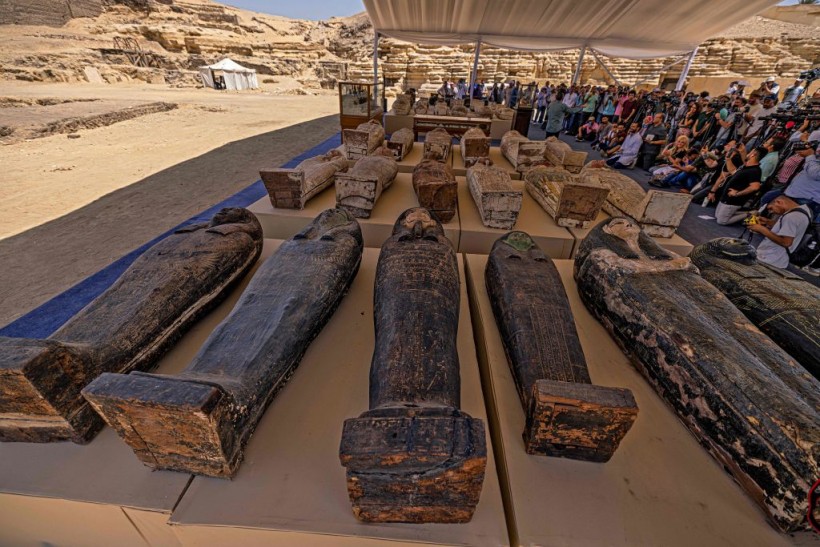Egypt presented yet another archaeological finding from one of its sites located in Saqqara. The new trove includes 250 undisturbed mummies that were hidden in sarcophagi made of wooden materials. Alongside the mummified bodies, over 100 bronze statues of what appear to be ancient Egyptian gods were also buried beneath the place.
In a statement released by Egypt's antiquities ministry, the latest discoveries date to around 2,500 years ago, right during the Late Egyptian Period.
New Ancient Egyptian Trove Unearthed Near Pyramid of Djoser

Sarcophaguses found in a cache dating to the Egyptian Late Period (around the fifth century BC) are displayed after their discovery by a mission headed by Egypt's Supreme Council of Antiquities, at the Bubastian cemetery at the Saqqara necropolis, southwest of Egypt's capital on May 30, 2022. - Egypt on May 30 unveiled a cache of 150 bronze statues depicting various gods and goddesses including "Bastet, Anubis, Osiris, Amunmeen, Isis, Nefertum and Hathor," along with 250 sarcophagi at the Saqqara archaeological site south of Cairo, the latest in a series of discoveries in the area.
The Saqqara collection was unearthed right from the 'Cemetery of Ancient Animals.' This temple, also known as the 'Bubasteion,' is located just right on the outskirts of Cairo city. The name of the place references an ancient Egyptian god Bast (sometimes Bastet) which commonly appears and is worshiped in its cat form.
Just right after it was renamed in 2019, the complex was discovered with additional collections including more mummified animals as well as statues of various Egyptian gods.
Excavation director Mohammed Al Saidi explained in a CBS News interview that the dig confirmed how the temple was not exclusive to cats, but held artifacts from other Egyptian deities, too.
The findings were presented by the archeological team as well as the authorities on Monday, May 31. The announcement included the exhibit of some of the mummies and statutes they collected right in front of the Saqqara's Step Pyramid of Djoser.
The Saqqara necropolis could be found on the edge of a desert plateau about 25 kilometers south of Cairo. In the past, the burial ground was already extracted with some of the modern-age discoveries since 2018.
The new dig marks the fifth major announcement of artifacts from the place. In 2020, there was a separate batch of mummified human remains that summed up almost 60 individuals, Live Science reports.
ALSO READ: Genetic Heritage of Ancient Pompeii Victims Discovered Through Genome Sequencing
Late Egyptian Period Artifacts Largest Collection from Saqqara Necropolis to Date
During the Late Period of Egypt, the country was dominated by rulers from the Achaemenid Persians. Still, their heritage persisted and was conserved properly for us to discover. This age gave birth to many ancient structures such as temples and medium-sized pyramids.
The bronze statue collection of Egyptian gods in Saqqara included figures of fertility god Amon-Min, Bastet's son Nefertem, underworld god Anubis, and the great Osiris as well as his wife Hathor. The wooden sculptures included Isis and her sister Nephthys.
Pieces of reed paper called papyrus were also scattered across the site. The sheets were unrolled yet, but experts estimated that the size of the papers extends to about 10 meters in length and likely contain chapters from the Egyptian Book of the Dead. This type of book was written with instructions on how to carry out a journey through the afterlife.
The Egyptian antiquities ministry says that this recent excavation is the first to discover such an amount of ancient artifacts in the Saqqara site. The Step Pyramid of Djoser, however, is a much older structure, being built about 2,700 BC during Egypt's third dynasty. The pyramid is suspected as the earliest stone building ever built.
RELATED ARTICLE: Ancient Human Remains from Colonial Era Unearthed in Peru, With Deformed Skulls and Likely Died from Syphilis
Check out more news and information on Archaeology in Science Times.



![Earth's Quasi-Moon Kamo‘oalewa Could Originate From Lunar Surface Not Asteroid Belt [Study]](https://1721181113.rsc.cdn77.org/data/thumbs/full/53275/89/56/50/40/earths-quasi-moon-kamo-oalewa-could-originate-from-lunar-surface-not-asteroid-belt-study.png)










